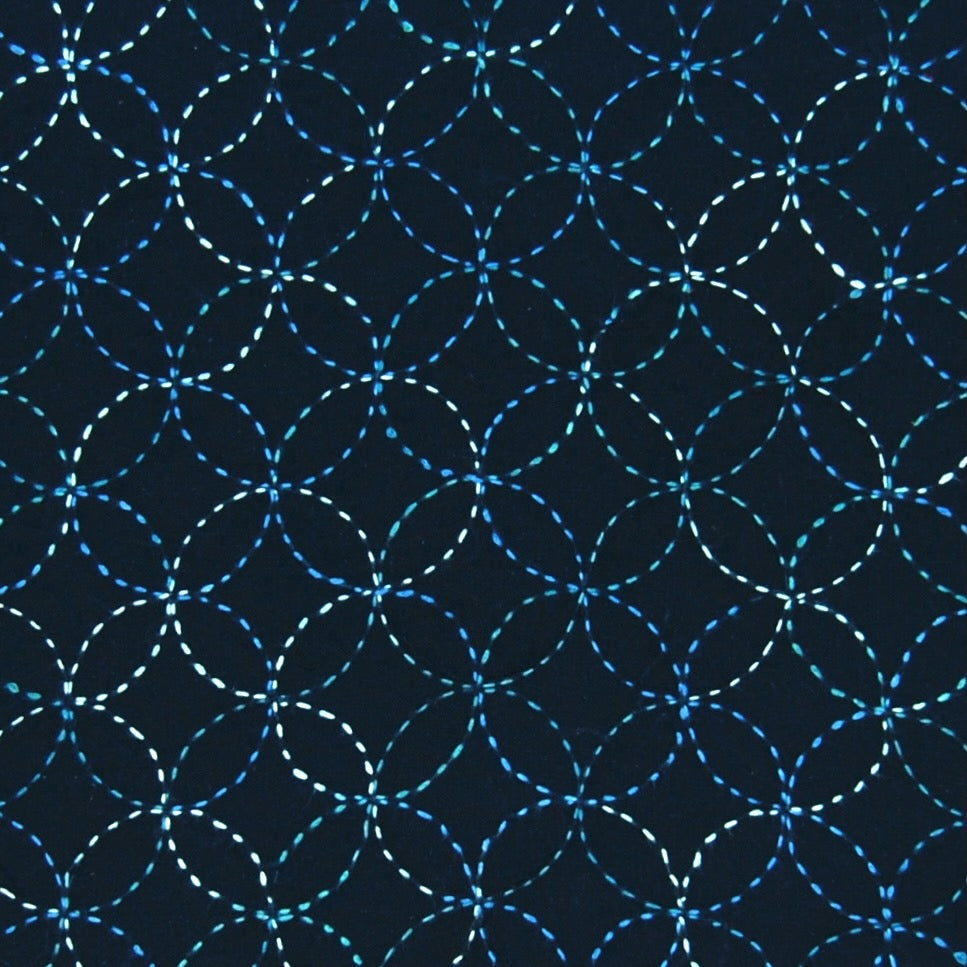
General information for sashiko stitching pre-printed samplers
How to Stitch Sashiko Samplers, General How To Information
Not all the sashiko samplers are the same, but they all have some things in common. One is that the instructions are mostly in Japanese only :-) I've written instruction blogs for some of the individual designs in my blogs on this website and will write more, but here are some general instructions that apply to them all.
First, here is a brief description of the 4 styles of sashiko stitching that these ready to stitch samplers are available in:
Moyozashi sashiko is the traditional large sashiko patterns originally used to stitch layers of fabrics together to make it warmer and/or stronger although currently most of us are stitching it just for the beauty :-). Most of us start our sashiko adventure with these designs, which are usually just called sashiko.

Hitomezashi is a sashiko stitching style in which the designs are made up of single stitches stitched in straight lines across the fabric. The stitching covers the fabric much more densely than the Moyozashi sashiko and was originally used to reinforce areas of fabric and clothing that get a lot of wear, but again we are mostly stitching this to to make decorative fabrics because it is so beautiful! :-)

Kugurizashi is a more advanced two part sashiko stitching technique which involves using the Hitomezashi stitching as the base layer to weave threads under to create beautiful patterns and textures.

Sashiko Stitching used for Imagery These samplers may use any, or all, of the three sashiko stitching styles above to create images.

Things you need to know before you start a sashiko sampler:
All the sashiko samplers from Olympus Japan are printed on the same sarashi-momen cotton fabric (Olympus Hana-fukin & Traditional Sashiko, La bouquetiere, Ayufish int. Samplers). This traditional 100% cotton Japanese fabric is woven on the traditional width narrow looms. This means the samplers have selvedges on two edges. The 12" x 12" design is printed on a 26" length of the fabric and you are meant to fold the unprinted half to the back of the printed half and stitch through both layers.
The printed design will disappear completely in water so keep it dry until you are finished. Also do not iron before it has been washed.
You can use any of the sashiko threads and needles for these samplers.
You can start your sashiko stitching with a knot and after that weave your threads under a few stitches on the back of the cloth. There are other methods, but this is a good way to start I think.
If you would like your cloth to have finished edges, fold the cloth in half with the printed side inside and stitch the together about 1/2" from the raw edge. (I use a running stitch and sashiko thread, but you could do it on a sewing machine)
Now, turn the cloth right side out (print on the top) and finger press the seam flat (no ironing!)
Smooth the fabric layers out, then stitch the two rows around the outer edges.
Two sashiko basics:
1. Putting many stitches on the sashiko needle at a time. This will give you straighter more even stitching, and it goes along much faster.

2. Sashiko stitching is dense so it is important to keep you stitching threads quite loose and to leave a small loop on the back of the fabric at the end of every line you stitch. I also stop frequently and holding the edges of the fabric on opposite sides, pull firmly. Repeat in several places. This will very likely pull those small loops into the fabric so they disappear and that will make it possible for the finished cloth able to lay flat as the stitches accumulate in it.

Sashiko is easy and relaxing to do. All the designs are built on repetitive use of the very simplest of stitches (the straight sashiko stitch). Even the designs that look impressively complicated break down into simple steps that build into the finished design.
It is also rather addictive, but in a good way :-)
Enjoy your stitching,
Kind Regards,
Susan

